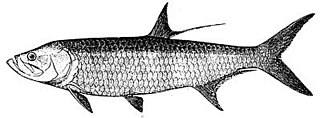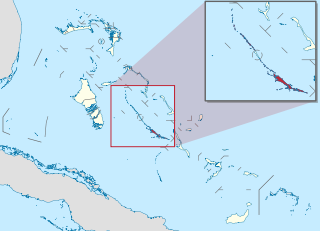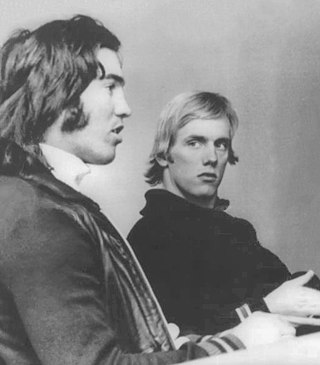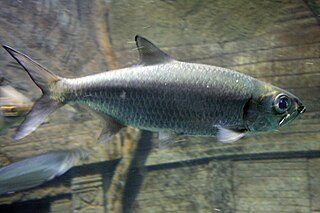Grand Slam or Grand slam may refer to:

Fly fishing is an angling technique that uses an ultra-lightweight lure called an artificial fly, which typically mimics small invertebrates such as flying and aquatic insects to attract and catch fish. Because the mass of the fly lure is insufficient to overcome air resistance, it cannot be launched far using conventional gears and techniques, so specialized tackles are used instead and the casting techniques are significantly different from other forms of angling. It is also very common for the angler to wear waders, carry a hand net, and stand in the water when fishing.

The Elopiformes are the order of ray-finned fish including the tarpons, tenpounders, and ladyfish, as well as a number of extinct types. They have a long fossil record, easily distinguished from other fishes by the presence of an additional set of bones in the throat.

The bonefish is the type species of the bonefish family (Albulidae), the only family in order Albuliformes.

USS Bonefish (SS-223) was a Gato-class submarine, the first United States Navy ship to be named for the bonefish.

Exuma is a district of The Bahamas, consisting of over 365 islands and cays.

Andy Ray Mill is a former alpine ski racer on the U.S. Ski Team. He was two-time Olympian, competing primarily in the downhill and combined events on the World Cup circuit.

The Atlantic tarpon is a ray-finned fish that inhabits coastal waters, estuaries, lagoons, and rivers. It is also known as the silver king. It is found in the Atlantic Ocean, typically in tropical and subtropical regions, though it has been reported as far north as Nova Scotia and the Atlantic coast of southern France, and as far south as Argentina. As with all elopiformes, it spawns at sea. Its diet includes small fish and crustaceans.

The Indo-Pacific tarpon, also known as the oxeye herring or simply herring due to its superficial resemblance to the true herrings, of which it is not a member, is the smaller of the two species of tarpon and lives in Indo-Pacific waters.

A topwater fishing lure or walker is a type of surface fishing lure, usually floating just at the water surface, that may be moved about the surface of water in order to attract and cause fish to attempt to strike the lure. Non-floating versions may be retrieved at sufficient speed to cause them to travel at the water's surface.

An artificial fly or fly lure is a type of fishing lure, usually used in the sport of fly fishing. In general, artificial flies are an imitation of aquatic insects that are natural food of the target fish species the fly fishers try to catch. Artificial flies are constructed by fly tying, in which furs, feathers, thread or any of very many other materials are tied onto a fish hook.

The permit is a game fish of the western Atlantic Ocean belonging to the family Carangidae. Adults feed on crabs, shrimp, and smaller fish.

Albulidae is a family of fish, commonly known as the bonefishes, that are popular as game fish in Florida, select locations in the South Pacific and the Bahamas and elsewhere. The family is small, with 11 species in 3 genera. Presently, the bonefishes are in their own order: Albuliformes. The families Halosauridae and Notacanthidae were previously classified in this order, but are now, according to FishBase, given their own order Notacanthiformes. The largest bonefish caught in the Western Hemisphere is a 16-pound, 3 ounce example caught off Islamorada, Florida, on March 19, 2007.

Big Ambergris Cay is a private residential island and home to Ambergris Cay Private Island Resort, located within the Turks and Caicos Islands. Not to be confused with Ambergris Caye in Belize, Big Ambergris Cay is situated to the southeast of the main chain of the Caicos islands. Adjacent to Big Ambergris Cay is Little Ambergris Cay, which is an uninhabited natural reserve. Little Ambergris Cay is a unique and significant habitat for a wide range of birds and marine life. Big Ambergris Cay island is approximately four miles long, one mile wide, and 1,100 acres (4.5 km2) in total.

Tarpon are fish of the genus Megalops. They are the only members of the family Megalopidae. Of the two species, one is native to the Atlantic, and the other to the Indo-Pacific Oceans.

Albula is an ancient genus of fish belonging to the family Albulidae. Members of this genus inhabit warm coastal waters worldwide.

Andrew "Drew" Chicone is an American author, saltwater fly designer, fly fisherman and fly casting instructor. He writes books and magazine articles demonstrating how to tie saltwater fly patterns, primarily focused on warm-water fish and fly fishing from standup paddleboards.

The Crazy Charlie is a bonefish fly for saltwater fly fishing developed on Andros Island in 1977 in the Bahamas by local bonefish guide Charlie Smith and popularized by San Francisco angler Bob Nauheim. They fly was developed to imitate glass minnows, a common forage for bonefish on the nearshore flats of south Florida and Caribbean islands. The Crazy Charlie has become a staple fly for bonefish and permit anglers around the globe.
Flats fishing is a method of fishing where anglers target species of fish specifically in shallow, saltwater bodies of water.

Bonefish fly patterns are a collection of artificial flies routinely used by fly anglers targeting various species of Bonefish. Bonefish frequent tidal sand and mudflats in tropical and sub-tropical latitudes to feed on benthic worms, fry, crustaceans, and mollusks. Bonefish have small mouths and most Bonefish flies are tied on size 4 to 8 saltwater fly hooks.














